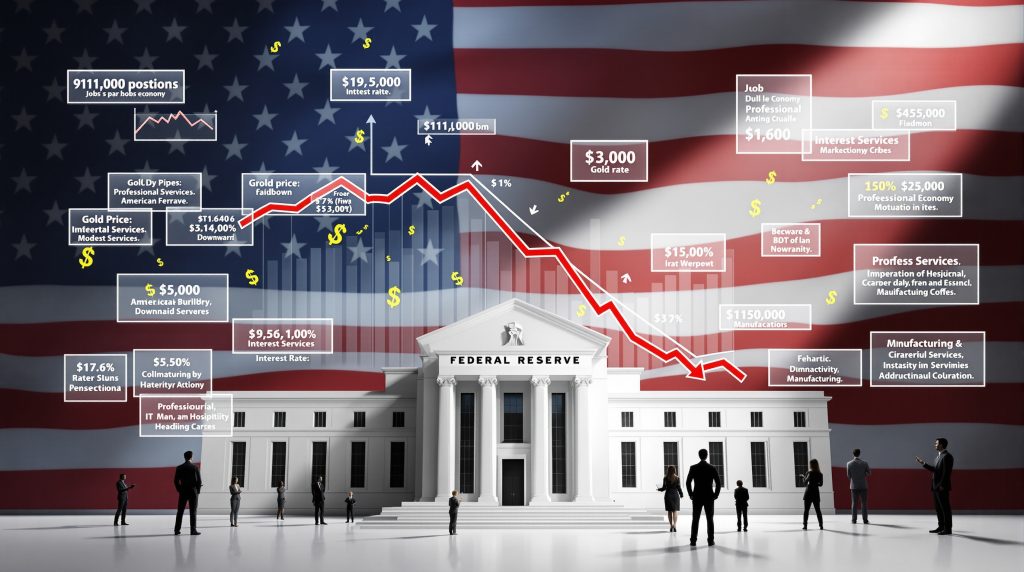What Does the Record Job Market Revision Reveal About the US Economy?
The recent preliminary benchmark revision from the Bureau of Labor Statistics has sent shockwaves through economic circles, erasing 911,000 jobs from official employment counts through March. This staggering adjustment—the largest in over a decade—suggests the US economy has been standing on far shakier ground than previously understood. The US job market revision and economic implications paint a dramatically different picture of labor market health, with significant consequences for monetary policy, market sentiment, and economic forecasting.
Understanding the Scale of the Revision
The downward adjustment of nearly one million jobs represents a fundamental reassessment of economic conditions. This revision primarily affected data from 2023 onward, revealing a substantial decline in employment growth that had previously gone undetected in official statistics. Such a significant correction raises critical questions about the reliability of economic indicators that guide both policy decisions and market expectations.
According to official BLS data, this revision surpasses the adjustment following the 2009 financial crisis (-902,000 jobs), making it the largest downward revision in modern economic history. The magnitude suggests systematic measurement challenges rather than simple statistical noise.
Key Sectors Affected by the Revision
The revision didn't impact all sectors equally:
-
Professional and business services faced the steepest cuts, with consultancies and administrative services particularly hard hit
-
Information technology sector showed substantial downward adjustments, revealing vulnerabilities in what was considered a resilient growth area
-
Leisure and hospitality employment was significantly lower than reported, despite apparent recovery narratives
-
Manufacturing jobs were fewer than initially calculated, pointing to continued industrial challenges
This sectoral breakdown reveals structural weaknesses in areas previously considered resilient, suggesting a more widespread economic slowdown than originally perceived.
The revision highlights a critical gap in measurement methodology, particularly the declining survey response rates that have challenged data collection since the pandemic. The BLS birth-death model, which estimates job creation from new business formation, appears increasingly misaligned with post-pandemic economic conditions.
How Might the Federal Reserve Respond to Weaker Employment Data?
Potential Shift in Monetary Policy Direction
The Federal Reserve's monetary policy decisions rely heavily on employment data as a key indicator of economic health. With the revelation that job growth has been substantially weaker than believed, the Fed may need to recalibrate its approach:
-
Interest rate decisions will likely become more dovish to support a more fragile labor market
-
The pace of planned rate cuts could accelerate beyond the previously telegraphed schedule
-
Quantitative tightening might be paused or reversed if employment weakness persists
-
Forward guidance may shift to emphasize economic support over inflation concerns, marking a significant pivot
The current federal funds rate stands at 5.25-5.50%, providing substantial room for easing if the Fed determines the employment situation warrants intervention.
Market Expectations for Rate Cuts
Financial markets have already begun pricing in more aggressive rate cuts in response to the revised employment figures. According to the CME FedWatch Tool, probability metrics for rate cuts have shifted dramatically following the revision announcement.
Market participants now anticipate a more aggressive easing cycle, with expectations for total cuts in 2024-2025 increasing significantly. This anticipation reflects growing concerns about economic momentum and recognition that the Fed may need to provide more substantial support than previously expected.
Balancing Inflation Concerns with Growth Support
The Fed now faces a delicate balancing act between addressing persistent inflation and supporting a labor market that appears increasingly vulnerable. This tension could lead to policy innovations or a fundamental reassessment of the Fed's dual mandate implementation in the current economic environment.
Recent Federal Reserve communications have emphasized data dependency, but the substantial revision to employment data may force a more dramatic shift in rhetoric and policy action. The challenge will be maintaining credibility while pivoting to address previously unrecognized labor market weakness.
What Are the Broader Economic Implications of the Revised Job Numbers?
Impact on Business Confidence and Investment
The substantial downward revision in employment figures may significantly affect business sentiment:
-
Companies may become more cautious about expansion plans, particularly in sectors showing the greatest employment weakness
-
Capital investment decisions could be delayed or scaled back as businesses reassess demand forecasts
-
Hiring intentions might weaken further, creating a negative feedback loop as consumer spending power diminishes
-
Corporate earnings projections may need downward revisions, particularly for companies dependent on discretionary consumer spending
Business formation statistics from the Census Bureau will provide early indicators of whether entrepreneurial confidence has been shaken by the revised employment picture.
Consumer Spending and Sentiment Considerations
Consumer behavior, which drives approximately 70% of US economic activity, could shift in response to the revised employment picture:
-
Household spending may become more conservative, particularly for big-ticket items and discretionary purchases
-
Major purchases might be postponed as job security concerns increase
-
Savings rates could increase as precautionary behavior intensifies amid greater perceived economic uncertainty
-
Consumer confidence metrics may decline further as employment narratives shift from strength to vulnerability
Early indicators suggest a shift in consumer psychology is already underway, with high-frequency spending data showing increased caution in discretionary categories.
Housing Market Vulnerabilities
The housing sector, already navigating challenges from elevated mortgage rates, could face additional pressures:
-
Potential homebuyers may delay purchases due to job security concerns, further slowing transaction volumes
-
Construction activity might slow further, exacerbating housing supply constraints in many markets
-
Price pressures could emerge in some markets as supply and demand fundamentals shift
-
Mortgage application volumes may decrease as employment uncertainty combines with still-elevated financing costs
Housing market dynamics are particularly important to monitor as they represent both a leading economic indicator and a critical wealth component for many households.
How Does This Revision Compare to Historical Precedents?
Previous Major Employment Data Revisions
While employment data revisions occur annually, the magnitude of the current adjustment stands out historically:
| Year | Revision Amount | Economic Context |
|---|---|---|
| 2009 | -902,000 | Great Recession aftermath |
| 2023-2024 | -911,000 | Post-pandemic adjustment |
| 1991 | -640,000 | Early 1990s recession |
| 2002 | -523,000 | Dot-com bubble aftermath |
The current revision rivals the adjustment following the 2008 financial crisis, suggesting comparable measurement challenges and economic uncertainty.
This historical context reveals a pattern: major downward revisions often precede or coincide with significant economic slowdowns or recessions. The parallels with previous revision episodes raise serious questions about current economic trajectory.
Structural Changes in Employment Measurement
The substantial revision highlights potential methodological challenges in measuring employment in a rapidly evolving economy:
-
Declining survey response rates compromise data quality, with the Current Employment Statistics survey experiencing participation challenges
-
The birth-death model for business formation may be misaligned with current economic conditions, particularly in estimating job creation from new businesses
-
Gig economy and remote work arrangements complicate traditional measurement approaches designed for conventional employment relationships
-
Seasonal adjustment factors may not adequately capture post-pandemic employment patterns and structural shifts
These measurement challenges are not merely technical issues—they represent fundamental difficulties in understanding the evolving nature of work and economic activity in the post-pandemic economy.
What Global Economic Factors Are Influencing the US Labor Market?
International Economic Uncertainties
The US job market doesn't exist in isolation—global factors are creating additional headwinds:
-
Political instability in many regions affects trade relationships and supply chain reliability
-
Ongoing geopolitical tensions affecting trade and investment flows create uncertainty for businesses making employment decisions
-
Supply chain realignments creating sectoral disruptions as companies reconsider global footprints
-
Monetary policy divergence between major central banks creates currency and trade implications
These international factors compound domestic challenges, creating a complex environment for labor market participants and policymakers alike.
Market Signals and Safe Haven Trends
Financial markets are sending clear signals about economic uncertainty:
-
Gold prices have reached historic highs, reflecting growing demand for traditional safe haven assets
-
Bond markets show persistent inversion patterns, historically a reliable recession indicator
-
Currency volatility has increased as markets reassess relative economic strength and policy directions
-
Defensive positioning has become more prevalent across asset classes, indicating growing risk aversion
These market movements reflect growing concerns about economic stability and suggest a shift toward risk-off sentiment among investors. The collective wisdom of market participants appears to be pricing in significant global recession risks ahead.
How Might These Economic Conditions Evolve in the Coming Months?
Potential Scenarios for Economic Growth
The revised employment data opens several possible paths for the US economy:
-
Soft Landing Scenario: The Fed successfully calibrates policy to support employment while managing inflation, avoiding recession. Economic growth slows but remains positive as labor market stabilizes.
-
Mild Recession Scenario: Economic activity contracts modestly as labor market weakness spreads to other sectors, but recovery begins within 2-3 quarters as policy support takes effect.
-
Stagflation Risk Scenario: Persistent inflation combines with weak growth, creating policy challenges and extended economic difficulty as the Fed struggles with competing mandates.
-
Financial Instability Scenario: Labor market weakness triggers broader financial system stress, requiring more dramatic intervention as asset values adjust to deteriorating economic fundamentals.
The probability distribution between these scenarios has shifted meaningfully following the employment revision, with increased weight on more challenging outcomes.
Leading Indicators to Monitor
Several key metrics will provide early signals about which scenario is unfolding:
-
Weekly initial jobless claims trends offer high-frequency insight into labor market deterioration
-
Monthly private payroll growth from multiple sources provides confirmation or contradiction of official data
-
Labor force participation rate changes signal worker confidence and labor supply dynamics
-
Wage growth dynamics reveal employer sentiment and negotiating power shifts
-
Business formation statistics highlight entrepreneurial confidence
-
Credit availability measures indicate financial system stress and lending conditions
These indicators collectively provide a dashboard for monitoring economic trajectory, with particular attention to divergences between official statistics and alternative data sources.
What Are the Investment Implications of These Economic Developments?
Asset Allocation Considerations
The revised economic picture suggests potential adjustments to investment strategies:
-
Increased allocation to real assets as inflation hedges may be prudent given structural inflation pressures
-
Selective exposure to defensive equity sectors with stable cash flows and pricing power
-
Reassessment of duration positioning in fixed income as rate cut expectations accelerate
-
Strategic commodity exposure, particularly to precious metals and industrial inputs with supply constraints
-
Careful evaluation of real estate investments given employment uncertainty and changing occupancy patterns
Traditional 60/40 portfolios may face challenges in this environment, suggesting the need for more nuanced asset allocation approaches that incorporate alternative assets and gold safe haven insights.
Sector-Specific Opportunities and Risks
Different economic sectors face varying prospects in this environment:
| Sector | Potential Impact |
|---|---|
| Technology | Mixed – cost-cutting benefits vs. reduced capital spending |
| Healthcare | Relatively defensive with stable demand and demographic support |
| Consumer Staples | Defensive positioning but margin pressures from input costs |
| Financials | Challenged by potential credit quality concerns if employment weakens further |
| Energy | Supported by structural supply constraints and geopolitical premium |
| Materials | Benefiting from infrastructure spending and supply chain realignment |
This differentiated outlook suggests an active sector rotation strategy may outperform broad market exposure, with careful attention to valuation and quality factors.
The Role of Commodities in Portfolio Diversification
Hard assets and commodities may play an increasingly important role in investment portfolios:
-
Gold and silver serving as monetary debasement hedges with different industrial/monetary use profiles
-
Industrial metals benefiting from infrastructure spending and energy transition demand despite economic headwinds
-
Agricultural commodities providing inflation protection through essential consumption patterns
-
Energy resources maintaining structural supply constraints despite potential demand moderation
Commodities have historically performed well during periods of economic uncertainty and inflation, suggesting a potential strategic allocation beyond tactical trading opportunities.
The silver market presents a particularly interesting case study, with both industrial and monetary demand drivers creating potential for significant price appreciation in a stagflationary environment. Historical price patterns suggest resistance at the $50 level, but a breakout above this level could open significant upside potential.
FAQ: Understanding the US Job Market Revision
Why are job numbers revised so significantly after initial reporting?
Employment statistics rely on survey data and statistical models that require subsequent adjustment as more comprehensive information becomes available. The preliminary estimates use sampling techniques that can miss structural shifts in the economy, particularly during periods of significant change like the post-pandemic era. Declining survey response rates have further complicated the reliability of initial estimates.
Does this revision mean the US is heading for a recession?
While the revision doesn't guarantee a recession, it significantly increases economic vulnerability. The magnitude of the adjustment suggests the economy has less momentum than previously believed, making it more susceptible to additional shocks or policy missteps. Historical patterns show major downward employment revisions often precede or coincide with economic contractions.
How will this affect average workers and job seekers?
The revised figures suggest a more competitive job market with potentially slower wage growth and fewer opportunities than previously understood. Job seekers may face longer search periods, while employed workers might experience reduced negotiating leverage and job security. Industries with significant downward revisions may implement hiring freezes or even layoffs as they reassess workforce needs.
What industries might be most affected by these economic conditions?
Cyclical sectors like construction, manufacturing, and discretionary retail face greater challenges in a weakening labor market. Technology, particularly areas dependent on business investment, may also experience headwinds as companies become more cautious with spending. Defensive sectors like healthcare, utilities, and consumer staples typically weather economic uncertainty better, though with company-specific variations.
How might this affect housing affordability and the real estate market?
The combination of still-elevated mortgage rates and increased employment uncertainty creates mixed conditions for housing. While affordability remains challenged by financing costs, weakening demand could moderate price growth in some markets, potentially creating opportunities for well-positioned buyers. The rental market may see increased demand if potential homebuyers delay purchases due to employment concerns, supporting multifamily investments.
Navigating Economic Uncertainty
The substantial downward revision in US employment figures represents a significant reassessment of economic conditions. The labor market—previously considered a pillar of strength—now appears considerably weaker than believed, with implications spanning monetary policy, business planning, consumer behavior, and investment strategy.
This revelation comes at a particularly challenging time, as US inflation and debt create additional headwinds. The Federal Reserve faces difficult decisions balancing inflation concerns with the need to support a more vulnerable labor market, while businesses and consumers must navigate an increasingly uncertain landscape.
For investors, these developments suggest the importance of diversification, careful sector selection, and consideration of real assets as potential portfolio stabilizers. The coming months will be critical in determining whether the economy can achieve a soft landing or whether more significant adjustments lie ahead.
While economic forecasting always involves uncertainty, the magnitude of this revision serves as a humbling reminder of the challenges in measuring and predicting economic conditions—particularly during periods of structural change. Flexibility, adaptability, and careful monitoring of economic signals will be essential for navigating the path forward.
The commodity sector, particularly precious metals like gold and silver, may benefit from this economic uncertainty. Market indicators suggest growing interest in these traditional safe haven assets, with potential for continued appreciation as monetary policy shifts to address labor market weakness.
As with any period of economic transition, risks and opportunities will coexist. The key to navigating this environment successfully will be maintaining a balanced perspective, avoiding both excessive pessimism and unwarranted optimism, while remaining alert to changing conditions and policy responses. For those looking to adjust their approach, an investing guide 2025 may provide valuable strategies for the current economic landscape.
Want to Be Alerted to the Next Major Mineral Discovery?
Discovery Alert's proprietary Discovery IQ model instantly identifies significant ASX mineral discoveries, giving investors a critical edge in volatile market conditions. Visit our discoveries page to see how previous major mineral finds have generated exceptional returns, and start your 30-day free trial to position yourself ahead of the market.




